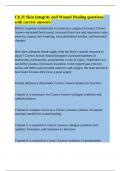Ch.31 Skin Integrity and Wound Healing questions
with correct answers
Bodie's response systemically to trauma (ex:surgical incision) Correct
Answer-increased body tempt, increased heart rate and respiratory rates,
anorexia, nausea and vomiting, musculoskeletal tension, and hormonal
changes.
How does adequate blood supply help the body's normal response to
injury? Correct Answer-blood transports increased numbers of
leukocytes, erythrocytes, and platelets to site of injury. Antibodies are
carried by plasma, increased circulation to the injured part removes
toxins and debris and provides nutrients and oxygen. the head and neck
heal faster because they have a good supply.
Protein deficiency diminishes Correct Answer-leukocytic function
Vitamin A is necessary for Correct Answer-collagen synthesis and
epithelialization
Vitamin B complex serves as a Correct Answer-cofactor of enzyme
reactions needed for wound healing
Vitamin C is needed for Correct Answer-collagen synthesis and
capillary formation, and resistance to infection.
Vitamin K is needed for Correct Answer-synthesis of prothrombin
,Zinc, copper, and iron assist in Correct Answer-collagen synthesis
Manganese serves as an Correct Answer-enzyme activator
what are the 4 phases of wound healing Correct Answer-hemostasis,
inflammation, proliferation, and maturation.
Describe Hemostasis Correct Answer-Occurs immediately after initial
injury, involved endothelial cells surrounding blood vessels constrict,
dilate and capillary permeability increase, allowing plasma and blood
components to leak out into the area that is injured, forming a liquid
called exudate. The accumulation of exudate causes swelling and pain.
Increased perfusion results in heat and redness. If the wound is small,
the clot loses fluid and a hard scab is formed to protect the injury. The
platelets are also responsible for releasing substances that stimulate other
cells to migrate to the injury to participate in the other phases of healing.
Describe Inflammatory phase Correct Answer-It follows hemostasis and
lasts 4-6 days. White blood cells primarily leukocytes, and macrophages,
move to the wound. Leukocytes arrive first to ingest bacteria and
cellular debris. About 24 hrs after the injury, macrophages enter the
wound area and remain for an extended period. Macrophages are
essential to the healing process. they not only ingest debris, but also
release growth factors necessary for growth of epithelial cells and blood
vessels. The growth factor also attracts fibroblasts that help to fill in the
wound, which is necessary for next stage. Acute inflammation is
characterized by pain, heat, redness, and swelling at the site of the
injury. During the inflamatory phase the patient has generalized body
, response, including a mildly elevated temperature, leukocytosis, and
generalized malaise.
Describe Proliferation Phase Correct Answer-Known as fibroblastic,
regenrative, or connective tissue phase. It lasts several weeks, new tissue
is built to fill the wound space, primarily through the action of
fibroblasts. They are connective tissue cells that synthesize and secrete
collagen and produce specialized growth factors responsible for
inducing blood vessel formation as well as increasing the number and
movement of endothelial cells. Capillaries grow across the wound,
bringing oxygen and nutrients required for continued healing.
Fibroblasts form fibrin that stretches through the clot. A thin layer of
epithelial cells forms across the wound and blood flow across the wound
is reinstituted.
The new tissue called granulation tissue forms the foundation for scar
tissue development. It is highly vascular, red, and bleeds easily.
Epidermal cells seal the wound within 24-48 hrs, thus the granulation
tissue is not visible.
In 5-7 days collagen synthesis and accumulation continue depending on
the size of the wound, collagen deposit continues for several weeks or
even years. By end of 2nd week, the wound is lighter in color, systemic
symptoms now typically disappear. During this phase, adequate nutrition
and oxygenation as well as prevention of strain on the suture line, are
important patient care considerations.
Maturation Phase Correct Answer-Final stage 3 weeks after injury,
possibly continuing for months and years. Collagen haphazardly
deposited in the wound is remodeled, making the healed wound stronger
and more like adjacent tissue. New collagen continues to be deposited
which compresses the bloodvessels in the healing wound so that the scar




